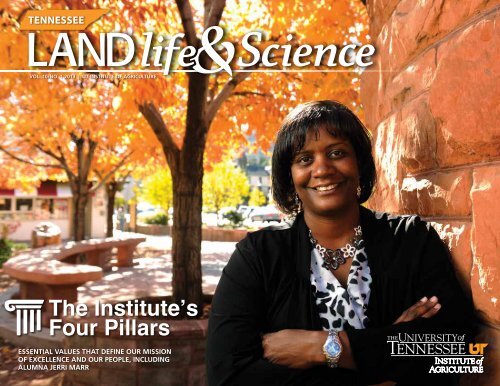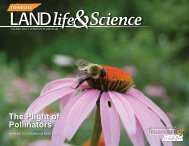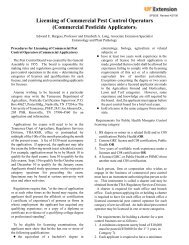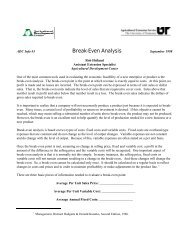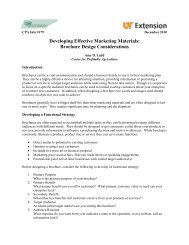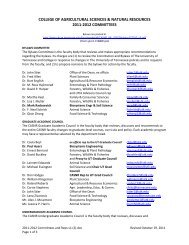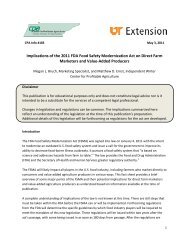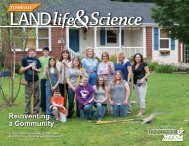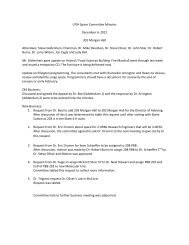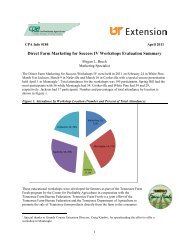Spring/Summer 2013 - The University of Tennessee Institute of ...
Spring/Summer 2013 - The University of Tennessee Institute of ...
Spring/Summer 2013 - The University of Tennessee Institute of ...
Create successful ePaper yourself
Turn your PDF publications into a flip-book with our unique Google optimized e-Paper software.
On the cover AlumnaJerri Marr. Photo by CyrusMcCrimmon, <strong>The</strong> Denver PostFeatures6 <strong>The</strong> four pillars <strong>of</strong> the<strong>Institute</strong> <strong>of</strong> Agriculture1610 New buildings, new horizons12 Premier equine hospitaltaking shape14 Bioenergy update20 Farm girl at heart opensdoors for hands-on learning2622 Fishery biologists revivea river24 Alumnus creates global fair,expo facilities26 Alumna forges partnershipsamid Waldo Canyon fire28 Back to school fornew faculty34 Advancing the instituteIn each issue4 News around the institute16 In pr<strong>of</strong>ile17 Inspirations18 Learning by doing30 Alumni memories32 Alumni dream jobs17322
Newsaround theinstituteBetter beansIt’s estimated that the UT Soybean Breeding andGenetics Program has given farmers a 5 bushel peracre yield advantage in recent years. That gain isexpected to increase with two new varieties.Released in partnership with the U.S. Department <strong>of</strong>Agriculture’s Agricultural Research Service, new varietyJTN-5203 features high yields with exceptionalresistance to multiple races <strong>of</strong> soybean cyst nematode,frogeye leaf spot, stem canker and suddendeath syndrome.Later this year, in cooperation with USDA-ARS andthe <strong>University</strong> <strong>of</strong> Missouri, scientists will release JTN-4307. This maturity group V soybean also exhibits resistanceto multiple SCN races, along with resistanceto FLS, Southern root knot nematode, Reniformnematode and stem canker — traits that modernplant biotechnology is helping make possible.Ginger RowseyDedicated4Mary RogersRich MaxeyAt Ag Day, Senior Vice Chancellor <strong>of</strong>Agriculture Buddy Mitchell joinedwith Chancellor Larry Arrington andUT President Joe DiPietro to unveila plaque dedicating key areas <strong>of</strong> thePlant Biotechnology Building in honor<strong>of</strong> Robert and Nancy Burchfiel. “Wethank Edith Burchfiel Cooper for supportingUT and the institute throughher memorial for her parents,” saidArrington. “Mrs. Cooper's gift to theinstitute supports our programs andpeople, and we express appreciation toher, her estate and trustee for this gift.”
Success<strong>Institute</strong> fisheries biologists are finding successin efforts to restore lake sturgeon in the easternreaches <strong>of</strong> the <strong>Tennessee</strong> River. Using trotlines, theyare catching sturgeon <strong>of</strong> different ages, signifyingthat successive years <strong>of</strong> releases are working. Somefish are tagged; all are returned to the water. Ourscientists are also discovering sturgeon are movingthrough the river's system <strong>of</strong> locks and dams.VisionaryBobby SimpsonComfortable cowsDan WalkerThose sand-based free-stalls look reallycomfortable, don’t they? Cows at East<strong>Tennessee</strong> AgResearch and EducationCenter’s Little River Animal and EnvironmentalUnit have access to sand-basedstalls between milkings. At the unit, housingand management factors on the welfare<strong>of</strong> cows are major areas <strong>of</strong> study, withresearchers analyzing changes in behavior,health or productivity <strong>of</strong> dairy cows,heifers and calves for optimal production.Since November 2011, a total <strong>of</strong> 18 animaland environmental research projectshave been launched at the new Walland,Tenn., complex, with many more plannedfor the future.Rosalie WinardVisionary animal welfare advocate Temple Grandinwas the keynote speaker at April’s College <strong>of</strong> VeterinaryMedicine Social Work Summit. Grandin isiconic for her designs <strong>of</strong> humane livestock handlingfacilities and for finding ways to use the gifts <strong>of</strong>autism in her life and career. She told a standingroom-onlyaudience that it’s important to understandthat animals are sensory beings — and so arepeople with autism. “An animal’s memories aresights, sounds, smells, taste and touch. … To understandanimals, we must be much more observant <strong>of</strong>the small details that really, really matter. You haveto work at it and get away from using words. Whenwe think in words, we tend to oversimplify.”5
Since joining the <strong>Institute</strong> <strong>of</strong> Agriculture 21months ago, Chancellor Larry Arringtonhas been doing a lot <strong>of</strong> listening andevaluating. From those listening sessions,he’s developed “Four Pillars” to lead UTIA’sfuture efforts. We sat down with Arringtonto learn more about the four pillars and hisvision for UTIA.6
OurFourPillarsby Tiffany CarpenterAdvancing Academic Excellence — Achievingacademic excellence throughout UTIA requiresinvestments in students, faculty and programs. Resourcesto support efforts in new and emerging areas are criticalto advancing the institute. Within UTIA, our programs,people and resources are committed to providing studentsin the College <strong>of</strong> Agricultural Sciences and NaturalResources and the College <strong>of</strong> Veterinary Medicine withopportunities to stretch their academic abilities while expandingand enhancing research and outreach.Delivering Discoveries — UTIA scientists generatenumerous technologies that address globalproblems, but UTIA needs to better support faculty t<strong>of</strong>acilitate the development from startup to market place.Private industry partnerships will help to accomplish thisand deliver our inventions and intellectual property to<strong>Tennessee</strong> producers.Promoting Hands-on Learning — Our graduatesand 4-H youth face a fast-changing society andmust develop skills to adapt to and drive the change. Providingoutside-the-classroom experiences affords themwith relevant, real-life opportunities to put the knowledgegained via traditional methods to practical use.This prepares them for the real world, heightens theirstatus for potential employers, and helps UTIA achieveits mission <strong>of</strong> advancing society.Serving Our Communities — Community accessto the resources and programs <strong>of</strong> UTIA are vitalto our state. We will continue to work with our partnersin communities throughout <strong>Tennessee</strong> to provide qualityprograms that address the unique needs and issues <strong>of</strong>each community we serve, whether we're talking aboutgeographic communities or communities <strong>of</strong> sharedinterests.7
OurFourPillarsQ&A withChancellor ArringtonWhat inspired the Four Pillars?In my first year as I got to know the institute, I paidattention to what people said they needed from us.I took a lot <strong>of</strong> notes and kept looking for themes,and from these, four areas <strong>of</strong> concentrationemerged. <strong>The</strong> more I thought <strong>of</strong> them, the moreevident they were as foundations, pillars if you will,for who we are and what we do.We are very fortunate to have a good foundationlaid by those who were in our positions before us.Some other states lost sight <strong>of</strong> the land-grant mission,but UT didn’t. <strong>The</strong> land-grant mission <strong>of</strong> research,teaching and outreach that changes lives iswhat this place is about. We are committed to keepdoing what the people <strong>of</strong> <strong>Tennessee</strong> need us todo, which means we understand our value is beingin every county in the state, positioned to provideresearch based on regional needs, and providingstudents with life-ready preparation through undergraduate,graduate and pr<strong>of</strong>essional educationalexperiences.Tell us a little bit about the four pillars:Advancing Academic Excellence — We wantto provide the very best experience for ourstudents, and we want to recruit the very best studentsand faculty. In order to do that, we need toincrease our capacity with scholarships and studentlearning opportunities, create more endowmentsfor faculty recruitment and retention, andform partnerships to advance in certain areas <strong>of</strong>demands.Delivering Discoveries — We have to find away to move the innovations created withinthe institute into the marketplace. It’s a commonbusiness startup issue. Our faculty members aregreat scientists, and we are making significant advancementsthrough research, and we need opportunitiesto get these important initiatives into themarketplace.Promoting Hands-on Learning — Industrycontinues to tell us that students need applicable,hands-on experience, both in the U.S. andinternationally. We have the perfect venue to dothis beginning with our 4-H program. We need toget more people in the pipeline with these out-<strong>of</strong>the-classroomexperiences.Serving Our Communities — You can slicethe community pie in several ways. I tend tothink by county — supporting local 4-H or agricultureprograms. <strong>The</strong>re’s also regional researchcenters or by area <strong>of</strong> interest, like the NationalBobwhite Conservation Initiative. No matter howyou slice it, UTIA is a part <strong>of</strong> our communities.8
What are the challenges facing UTIA andhow do the four pillars impact these?We are very fortunate to have a governor who believesin and is very supportive <strong>of</strong> higher education.Unfortunately many <strong>of</strong> the areas in the institute arenon-formula units like research and Extension. Fornon-formula units, which are not budgeted by fundingbased on enrollment, we have to work with thestate on the best paths for funding.<strong>The</strong> pillars we’ve identified help us address thechallenges we face by providing focused partnershipopportunities our constituents can grasp andbe a part <strong>of</strong>. Although we have challenges, thefuture is bright as we go forward.What opportunities are ahead for theinstitute and what relevance are thepillars to the future?Over the next decade we have to make sure weare moving in the right direction so we remainrelevant. We have to be proactive in engagingstakeholders so they can help us make good decisions.<strong>The</strong> pillars allow for this navigation andengagement. Our regional advisory councils helpus identify what concerns Tennesseans today andtomorrow, and we can use the pillars as vehicles tomove us into the future.<strong>The</strong> governor has challenged us, along with otherag leaders, to come up with a 10-year strategic planfor agriculture in the state <strong>of</strong> <strong>Tennessee</strong>, includinga substantial increase in agriculture productionto the economy <strong>of</strong> <strong>Tennessee</strong>. It’s an opportunityto speak to all the people <strong>of</strong> <strong>Tennessee</strong> about theimportance <strong>of</strong> ag and how UT fits in.What is your vision for UTIA in thenext 10 years?We have to be relevant and responsive. We need toclosely align our programs with the needs <strong>of</strong> thestate. We are doing business a lot differently todaythan we were 10 years ago. Technology forces us tochange, and we have to be changing with it. If wedon’t make good decisions now, it’s going to be verydifficult to keep up. Again, these four areas <strong>of</strong> focuswill help make us relevant and reliable for the next10-plus years.How will the pillars move UTIA forwardin attracting quality students andfaculty, as well as enhancing academicprograms?<strong>The</strong> pillars will help us raise the private gifts weneed for scholarships and faculty endowments.<strong>The</strong>y help us communicate what’s important to usand the state <strong>of</strong> <strong>Tennessee</strong> and what we’re about.People can see themselves fitting into our mission.We want to be more internationally involved inour academic programs but we don’t have enoughfaculty to let them explore it. <strong>The</strong> same is true withinternational travel and internships. We don’t haveenough students with international experience, andthere’s a big push by industry for that right now, sothat’s a big push for us.What can alumni and friends doto support these efforts?<strong>The</strong>re are several ways to support our efforts. Becomeadvocates for us through grassroots support;help us think about who could invest in our missionand who cares about what we are doing; help ustalk to them, communicate our needs and how itwill make a difference.We recently received an endowment from a UTalumna (Janet McKinley – see story on page 22)who did not have a tie to the institute, but sheheard me talk about our communities. We explainedwhat our role was and what it meant to thestate, and she saw how it fit with her. Her gift allowsstudents to go from Knoxville to <strong>Spring</strong> Hill, Tenn.,for experiential learning opportunities, ones thatthey, in turn, will bring back to the classroom.9
Advancing Academic ExcellenceAchieving academic excellence requires investments in students, faculty and programs.<strong>The</strong> new Brehm and Food Science buildings give them all the tools to succeed.Photos by Rich Maxey10
New buildings,new horizonsStudents, faculty and staff in the Department<strong>of</strong> Animal Science and the Department <strong>of</strong>Food Science and Technology made a move for thebetter in January as they left behind their temporaryquarters in McCord Hall for their highly anticipatednew facilities.<strong>The</strong> renovated Brehm Animal Science Buildingand the new Food Science Building feature state<strong>of</strong>-the-artclassrooms, labs and student study areas.Brehm’s renovations also feature a computer laband a modernized and expanded arena and holdingarea, while the new Food Science Buildinghouses an updated sensory evaluation lab and apilot processing plant.To alumni, the new buildings are unrecognizablecompared to their predecessors. To students, theyare inspiring.“<strong>The</strong> most exciting thing about the Food ScienceBuilding is the laboratories, which are well laid outand have sufficient space,” says Ph.D. student VinayMannam ’13.“<strong>The</strong> graduate student <strong>of</strong>fice in the new building isprobably the best student <strong>of</strong>fice on campus, with ariver view and lots <strong>of</strong> sunshine. And there’s plenty<strong>of</strong> greenery around the building. <strong>The</strong> new buildingwill be a great attraction to prospective graduatestudents as it is peaceful, elegant and energetic.”“As a senior animal science major, I’m really excitedto have class in new classrooms that are all updatedand have everything we need for learning,” saysSarah Orr ’13.“As a member <strong>of</strong> Block and Bridle, it's really excitingto be out in the arena and see our students andmembers helping with Round Up, and also to seepotential students, who are 4-H and FFA members,being involved with livestock and actually learningin our new arena.”Bill Brown, dean <strong>of</strong> AgResearch, says the buildingsopen up new horizons for both departments.“<strong>The</strong>se new state-<strong>of</strong>-the art laboratory facilities and,in Animal Science, the animal holding and workingfacilities will increase the capacity <strong>of</strong> our researchprograms and undergraduate and graduate teaching,as well as enhance the capacity <strong>of</strong> our Extensionprograms to producers.“And it’s ditto for Food Science. Research, teachingand outreach will all strongly benefit from newstate-<strong>of</strong>-the art classrooms and labs, including thepilot plant, sensory evaluation lab and domestickitchen. We couldn’t be happier with what thesefacilities will mean for the institute as a whole.”– Margot Emery and April Moore Massengill11
Advancing Academic ExcellenceWe want to provide the very best experience for studentsand clients, and to recruit the very best students and faculty.Phil Snow•<strong>The</strong> nearly 85,000-square-foot expansionand renovation <strong>of</strong> the Equine and FarmAnimal hospitals includes:12• Client reception area.• Equine Hospital with dedicated ICU(includes mare/foal ICU stalls); isolationfacility for contagious diseasecontainment; and orthopedic, standing,s<strong>of</strong>t tissue and colic surgical suites• Farm Animal Hospital with dedicatedwards for sheep and goats, llamas andalpacas, and cattle; outpatient cattleworking facility; inpatient treatmentfacility; farm animal rehabilitation suitewith dedicated down-cow stalls andhydr<strong>of</strong>loatation units; standing surgery;general surgery suites; and intensivecare unit capabilities.• Diagnostic imaging center (for bothlarge and small animal) that includesspiral CT, MRI and nuclear medicine.• Equine Performance and RehabilitationCenter that includes a lamenessdiagnostic center complete with eventsizedriding arena; podiatry and farrierfacility with forge; in-ground underwatertreadmill; free walker; whole bodyvibration therapy unit; cold saltwatertherapy unit; and solarium.• Ambulatory/field services unit includingfour fully equipped mobile servicevehicles.Premier facilities taking shapeat UT Veterinary Medical Center<strong>The</strong> <strong>University</strong> <strong>of</strong> <strong>Tennessee</strong> Veterinary MedicalCenter is proud to announce the completion<strong>of</strong> the new 60,000-square-foot expansion <strong>of</strong> itsequine hospital on the UT agricultural campus.<strong>The</strong> project includes extensive upgrades to theinfrastructure <strong>of</strong> the existing equine hospital andadds a 30,000-square-foot Equine Performance andRehabilitation Center.“We have tremendous people with tremendousexpertise,” says David Anderson, Large AnimalClinical Sciences Department head. “But we hadoutgrown a facility built in the mid-70s, so whatwe didn’t have was a tremendous workspace.” <strong>The</strong>$20.9 million, nearly 85,000-square-foot project,which includes both the Equine and Farm Animalhospitals, changes that. Construction and renovation<strong>of</strong> the Farm Animal Hospital is expected to becompleted early this summer.“This state-<strong>of</strong>-the-art facility will enable us to set thetone for the future <strong>of</strong> veterinary medicine withinthe performance and rehabilitation specialty,”Anderson says. “With the expansion, the UT College<strong>of</strong> Veterinary Medicine has made a commitmentto not only define excellence and innovation,but also to bolster the educational opportunities forstudents pursuing rural practice and for regionallarge animal veterinarians.”Carla Sommardahl, DACVIM (large animal), andinternal medicine section chief at the UT EquineHospital, says the new Charles and Julie WhartonIntensive Care Unit enhances patient care. “In ourICU, we now have an area where we can sit andwork, and still monitor our patients.” Sommardahladds that the unit allows intensive care patients tobe separated from the general population. “<strong>The</strong>ICU patients need a little bit more protection sincethese are animals that are the sickest and may bemore susceptible because <strong>of</strong> compromised immunesystems. With our new facility, we are able to watchthem carefully in an area <strong>of</strong> their own with someonehere 24/7 monitoring them and providingtreatments.”
Phil SnowGreg HirshorenSteve Adair, director <strong>of</strong> the Equine Performanceand Rehabilitation Center says, “<strong>The</strong> center adds anexciting new dimension to the UT EquineHospital that closes the circle on the concept<strong>of</strong> ‘total patient care.’ <strong>The</strong> new rehabilitationcenter contains the expertise, resourcesand equipment to manage patientsthat benefit from physical therapy, adjunctivetreatments and exercise conditioning.”This unit includes a full-sized indoor ridingarena; a lameness examination area withmultiple surface types for lameness diagnosisduring exercise; a resistance-free walkerfor controlled, untethered exercise; inground,underwater treadmill for exercisewith resistance but reduced body weight;equine cold saltwater spa with hydrotherapyfor treatment <strong>of</strong> laminitis, swelling, inflammationand soreness; podiatry center with ahot forge and expert farrier services to provideroutine and therapeutic shoeing for lameness,postoperative management, limb diseases androutine ho<strong>of</strong> care. Additionally, a dynamic video endoscopewill allow for thediagnosis <strong>of</strong> upper airway<strong>The</strong> services coupledwith board-certifiedexpertise make this one<strong>of</strong> the most comprehensivecenters for thediagnosis, treatmentand rehabilitation <strong>of</strong>horses in the world.disease in the horse whileit is being ridden or duringtreadmill therapy.<strong>The</strong> EPRC is also supportedby a team <strong>of</strong> boardcertifiedradiologists andthe Veterinary MedicalCenter’s John and AnnTickle Advanced ImagingCenter, which housesMRI, CT and nuclearscintigraphy for large andsmall animals. <strong>The</strong> EPRCis integrated with complementarytherapies including hyperbaric oxygentherapy, regenerative (stem cell) medicine, chiropracticand acupuncture. <strong>The</strong>se services coupledwith the medical center's board-certified expertisemake this one <strong>of</strong> the most comprehensive centersfor the diagnosis, treatment and rehabilitation <strong>of</strong>horses in the world.Partnering withPractitionersAnderson views the facility as an extension <strong>of</strong> the localveterinarian’s practice and anticipates maintaininga strong partnership with practitioners. “We willcontinue to foster an atmosphere <strong>of</strong> collaboratorssharing the mission <strong>of</strong> providing excellent care foranimals, which will enable us to stay on the leadingedge <strong>of</strong> meeting the needs <strong>of</strong> the practicing community,”Anderson says.“When practitioners refer cases to us, they are, ineffect, simply bringing more people onto theirhealth management team for their clients, and wewant to emphasize our role as a resource for themto expand their practice through our facilities andexpertise.” – Sandra Harbison13
Advancing Academic Excellence<strong>The</strong> institute delivers on its promise to support research andoutreach in new and emerging areas important to society.Bioenergy update$15 million USDA biomass project makes strategic progressCenter for Renewable Carbon Contributions:• Dr. Niki Labbé is leading an effort investigating the chemicalcomposition <strong>of</strong> two important energy crops: poplarand switchgrass. Understanding the natural variability <strong>of</strong>biomass as potential chemical feedstock is key to enablingthe commercialization <strong>of</strong> advanced fuels.• Dr. Berenger Biannic, CRC research associate, won firstplace for a postdoctoral submission at the inaugural SoutheasternConference Symposium. His winning poster discusseda new methodology using innovative catalysts thatgive access to high-value chemicals in high yields fromlignin subunit models. <strong>The</strong> poster was among 80 submittedunder the topic “Impact to the Southeast on the World’sRenewable Energy Future.”• CRC research has demonstrated the potential use <strong>of</strong> ligninas a feedstock for high-value, high-volume products likecarbon fiber and carbon foam, as well as nonwoven fabricsfrom polymer fiber. Carbon foams from lignin are projectedto improve energy efficiency in home heating by 50 percent.This advancement is currently under evaluation by theUT Research Foundation.• A recent CRC submission appearing in the journal CompositesA remains among the top 10 downloads from thejournal and the No. 1 cited article. This attests to theCRC’s leadership in the science and technology <strong>of</strong>advanced biocomposites.14
Photos from the Center for Renewable CarbonLindsey KlinePyoung Chung KimIt’s called the Southeast Partnership for IntegratedBiomass Supply Systems, or IBSS, and TimRials, director <strong>of</strong> the UT <strong>Institute</strong> <strong>of</strong> AgricultureCenter for Renewable Carbon, is managing the $15million U.S. Department <strong>of</strong> Agriculture effort. <strong>The</strong>CRC’s contributions will add up to approximatelyone-third <strong>of</strong> the massive research effort, but theteam includes dozens <strong>of</strong> scientists from multipleinstitutions and scientific disciplines. (See http://www.se-ibss.org for participants.) Together they areworking to develop sustainable feedstock productionsystems for energy crops grown in the Southeast,specifically switchgrass and woody biomass.“<strong>The</strong> goal is to provide a predictable and reliablesupply <strong>of</strong> biomass for conversion to advanced ‘dropin’ bi<strong>of</strong>uels — bi<strong>of</strong>uels that fit in today’s refineriesand pipelines, and can power today’s automobilesand aircraft,” says Rials. “We are ultimately focusedon demonstrating the production <strong>of</strong> advancedbi<strong>of</strong>uels from sustainable sources <strong>of</strong> lignocellulosicbiomass. <strong>The</strong> effort is targetingperennial switchgrass, annualsorghum and short-rotation woody crops likepoplar and pine.” He says one goal is to match theeconomic and environmental performance <strong>of</strong> eachfeedstock with a preferred conversion platform.Rials says the partnership is working to improvegrowing, harvesting, storing and converting biomassby developing genetically superior bioenergycrops, improved and environmentally soundproduction practices, and better harvesting andprocessing logistics that balance economic, socialand environmental sustainability factors.<strong>The</strong> IBSS Partnership is also working to incorporateinnovative outreach methods to increase publicawareness <strong>of</strong> bi<strong>of</strong>uels, including metrics for landownersand community groups involved in decisionmakingregarding the emerging bi<strong>of</strong>uels industry.Tim Rials and Niki LabbéEducation is another goal. In 2012 the IBSS Partnershipcreated the SouthEast Energy DevelopmentFellowship program for students. Participants spenta summer tackling real-world problems in feedstockproduction, feedstock logistics, conversion, or marketsand distribution <strong>of</strong> bi<strong>of</strong>uels. <strong>The</strong>y also visitedbiomass production sites, industrial partner facilities,national laboratories and universities. <strong>The</strong> firstSEED Fellows included undergraduates from Tuskegee<strong>University</strong> and Auburn <strong>University</strong>. (See http://www.se-ibss.org/about/seed-fellows.) <strong>The</strong> <strong>2013</strong> classwill be announced soon.<strong>The</strong> partnership formed in September 2011, andnow, approximately 20 months into the five-year effort,the partnership is making solid advancementstowards its goals. – Patricia McDaniels15
Nematode. Ascarid. Coccidia. Words near and dear toDr. Sharon Patton, the first female faculty member hired at theUT College <strong>of</strong> Veterinary Medicine. <strong>The</strong> distinguished servicepr<strong>of</strong>essor <strong>of</strong> parasitology has dedicated her entire pr<strong>of</strong>essionalcareer to studying worms, bugs, blood and guts.In pr<strong>of</strong>ile:Dr. Sharon PattonWhat is your favoriteparasite?Oh, it’s hard to say. My favorite used tobe strongyles in horses. Now it’s heartwormsin some way because there havebeen so many recent changes in them,and I have to keep up to date withthem. Toxoplasma is always up there.But then, <strong>of</strong> course, hookworms.How can you not love those voraciousbloodsuckers? I just love them all somuch! I love their life cycles and beingable to teach things that will improveanimal and human life.This is your 36th year teachingthe parasitology course.What excites you?Everything! But it doesn’t take a lot.I’ve looked at nematode eggs on afecal flotation who knows how manytimes now, but folks in the lab will calland say “you’ve got to come down andsee this!” and there will be somethingwe didn’t expect or the slide will becompletely covered with hookwormor roundworm eggs. While I’ve seenit many times in my life, I just can’ttake my eyes <strong>of</strong>f it! I always remindstudents to treat feces with respectsince they contain many clues to ananimal’s health.You’ve won several nationalteaching awards and areknown for telling your students,“Remember, I love you.”How do you help them rememberthings?My classes can be like an old-timegospel meeting with students yellingout answers. I ask questions and wantthem to answer so I can hear them —so the class next door can hear them.<strong>The</strong>re are some things they shouldnever forget. I’ll say, “Hookwormsare …” and they’ll yell, “VORACIOUSBLOODSUCKERS!”How do you prepare your studentsfor change?Most <strong>of</strong> what I teach I was nevertaught. <strong>The</strong> environment and internationaltravel has changed. If I wereteaching the same lectures I did 36years ago, I would be useless. Thatis the same for them as they go intoveterinary practice. <strong>The</strong>re is alwayschange. Remembering what I say isnot the same as remembering theprinciples: parasites will always havelife cycles, and there will always beinfective stages. <strong>The</strong>y need to understandhow that works and understandhow to stop the infection, not by justgiving a drug, but by stopping thetransmission.Are there any parasitesnamed after you?None. I tell my students that all mycolleagues (younger and older) havesomething (a parasite, a worm, anarthropod, a protozoa) named afterthem, and I do not. I remind them toname something after me.Your blood runs orange.Oh yes! I always wear orange on basketballand football game days, andwhen we play Alabama or Florida, Ihelp the team out by wearing orangeall week — even orange socks!16
InspirationsWhat inspired pr<strong>of</strong>essor, student to enter poultry science?Promoting Hands-on LearningProviding outside-the-classroom experiences prepares students forthe real world, heightens their status for employers, and helps UTIAachieve its mission <strong>of</strong> advancing society.Nicole DelFraino ’13, animal science majorMichael Smith, pr<strong>of</strong>essor <strong>of</strong>animal science“In Jamaica, where I am from, mydad was basically a subsistencefarmer. <strong>The</strong>re was a person who’dcome around and give him advice onnew varieties and on such things asplanting in rows instead <strong>of</strong> holes. Ijust thought that guy, an agriculturalinstructor, was a good person becausehe helped my dad and others likehim. I ended up going to agricultureschool because I wanted to bethat guy. In graduate school, I hadthe opportunity to study heat stressin poultry. Ithought heatstress wouldbe somethingrelevant to smallfarmers in Jamaicaand othertropical countries,and it’salso relevant tointegrated operationshere andworldwide. Heatstress is a realissue, becausechickens donot have sweatglands and caneasily die from heat. Through myresearch and publications on heatstress, I’ve shared information with<strong>Tennessee</strong> producers and around theworld on how to manage heat stressin poultry. Through my teaching I’veprepared students to enter the field<strong>of</strong> poultry production. <strong>The</strong>re is realdemand there. <strong>The</strong> students quicklyfind jobs … My original thinking wasthat I wanted to help small producers,and now I actually feel that I’vecontributed something. By specializingin poultry, in the final analysis, Ithink I’ve achieved what I started outto do.”Margot Emery“I entered UT wanting to go to vetschool. That’s what I wanted to dobecause I love animals. My sophomoreyear, I went to the CASNRCareer Fair and started talking witha Tyson recruiter about the poultryproduction plant near my hometownin Shelbyville (Tenn.). He asked formy resume to apply for an internship,and I thought, ‘OK, let’s see wherethis leads.’ I ended up going throughseveral interviews at their <strong>of</strong>fices inNorth Carolina. <strong>The</strong>y <strong>of</strong>fered me asummer job working in Shelbyville. Iworked as an operations intern, testingwater quality and talking with producerson whatto do to improvewater quality attheir productionhouses. By theend <strong>of</strong> summer,I had beento every farmthat feeds thecomplex. On mylast day, my bosstold me I hadmade an impact.It was nice toactually makea difference. For me, working inthe poultry industry isn’t all aboutmaking money at my job, it’s aboutfeeding people. Tyson is one <strong>of</strong> thebiggest companies donating food toother countries to feed the hungry,and I’m a part <strong>of</strong> that by working forthem. Tyson asked me to come backfor my short Christmas break. Mymom asked me why I was going back,and I said, ‘Because I like it.’ It maybe a job, but I don’t feel like it’s workbecause I enjoy what I do. I’m hopingto continue working for Tyson aftergraduation. Tyson calls itself a family,and that’s really true for me. <strong>The</strong>y’remy family now. It’s awesome!”Margot Emery17
Promoting Hands-on LearningNational studies find that employers give preference to students with out-<strong>of</strong>-classroomexperience. <strong>The</strong> institute is committed to ensuring its students have access to high-valueopportunities for experience in their fields.Our Tottingham HotspurTurfgrass management graduate Robert Moser, ’12, found new horizonsinterning with one <strong>of</strong> England’s top “football sides,” TottenhamHotspur, from May through November 2012. Moser helped open theclub’s new training center, one <strong>of</strong> the largest in Europe, featuring morethan 15 ryegrass pitches for use by juniors from the age <strong>of</strong> 8 all the wayup to the Premier League’s stars. “Throughout my stay, I met many individualswho showed me a different outlook on turfgrass managementand life in general. Study abroad gave me a look into the pr<strong>of</strong>essionalattributes and lifestyles <strong>of</strong> a culture that changed my perspective andoutlook on work, life, and the things that matter most to me.”Growing new horizons18Mary Wortham, a junior in landscape architecture,didn’t spend last summer pulling weeds. Her paidinternship, co-sponsored by the Cumberland CountyMaster Gardeners and UTIA’s Plateau AgResearchand Education Center, included drawing a landscapeplot for the center’s Discovery Gardens, coordinatinginstallation <strong>of</strong> the gardens’ waterfall feature, andexperiencing how UT Extension and UT AgResearchreach into local communities through programsthat include consumer and family sciences as well asfarming and gardening. “It was such a learning experience.<strong>The</strong> research and community outreach was real.I didn’t know anyone was doing this,” she said. WaltHitch, the center’s director, says Wortham learned theintricacies <strong>of</strong> agricultural research by assisting scientistsduring site visits. For example, she worked in the fieldlearning how roses are developed for commercial sale.<strong>The</strong> organizations she served considered her such asuccess, she has paved the way for another student whowill serve as intern this summer.
In high cottonFood and agricultural business major Cory Vineyardexpanded his horizons interning in Extension cottonprograms in Mississippi last summer. Back on campusin the fall, he conducted a special project calculatingthe economics <strong>of</strong> irrigation and plant growth regulationapplications on final yield output. “I am planningon going to graduate school and conduct my thesison an issue with cotton. Being from East <strong>Tennessee</strong>,the internship was a new and exciting adventure intothe world <strong>of</strong> cotton. With cotton acreage going downeach year in the United States, I hope the research Iconduct in the future will put cotton back on top <strong>of</strong>the list <strong>of</strong> commodities grown in this region.”A diamond in the landscapeIvy Renfroe may be best known around campus as one <strong>of</strong> the starpitchers for the Lady Vols s<strong>of</strong>tball team. She’s helped lead theteam to two NCAA Women's College World Series appearances andposted a personal win-loss record <strong>of</strong> 92-23. But this star athlete hascultivated an interest outside the s<strong>of</strong>tball diamond … landscaping.Renfroe is a plant sciences major who graduated this spring with adegree in landscape design. Her academic experiences have includedan internship at the UT Gardens in Jackson. Renfroe credits hergrandmother for introducing her to the joys <strong>of</strong> gardening. Some <strong>of</strong>her earliest memories are <strong>of</strong> helping her grandmother water flowers.Yet, she says it’s her time at the UT <strong>Institute</strong> <strong>of</strong> Agriculture that hasbroadened her knowledge and passion for plants. While her futurecareer plans are uncertain (she is considering playing s<strong>of</strong>tballpr<strong>of</strong>essionally after college), Renfroe is a competitor who will excelwhether it’s in the pitcher’s circle or a career in the green industry.And Vols, <strong>of</strong> course, will be rooting for her either way!19
Promoting Hands-on Learning and Serving Our Communities<strong>The</strong> institute prepares its graduates to excel in a fast-changing society. Its commitment to communities isto increase access to the university’s resources and programs.Janet McKinley opens doors for Hands-on learning for CASNR studentsColleagues who worked with Janet McKinleyin her 28-year career at BellSouth maybe surprised to learn that the executive is a farmgirl at heart.“I love the farm. I’m an outdoors person,” saysthe retired chief corporate auditor. McKinley,a 1980 graduate <strong>of</strong> UT’s College <strong>of</strong> BusinessAdministration, got her first taste <strong>of</strong> farm livingin 1972 when her family moved from Nashvilleto a 100-acre farm in <strong>Spring</strong> Hill, Tenn.Charlie BrooksJamie Evans20Janet McKinley, second from left, rode with institute leaders and Mark Wilson, regional vicepresident <strong>of</strong> Farm Credit Services, second from right, at the <strong>2013</strong> National Championship forfield trialing bird dogs. <strong>The</strong> event is held each winter at Ames Plantation in southwest <strong>Tennessee</strong>.
Her father, Bob, a 1948 graduate <strong>of</strong> UT Knoxville,and her mother, Barbara, soon made a name forthe family as breeders <strong>of</strong> championship <strong>Tennessee</strong>walking horses and Hereford cattle. <strong>The</strong> McKinleystypically had around six or seven walking horsebroodmares, along with weanlings and yearlings, ontheir farm.“I grew up (on the farm) and helped my parentswith the horses. We’d show them every Fridayand Saturday in the summer,” says McKinley. Shedreamed <strong>of</strong> being a veterinarian, but realized itwasn’t the career for her during a high school eventfor pre-med students.“While watching an operation I realized I had alow threshold for pain and didn’t like the sight <strong>of</strong>UT Extension andthe Middle <strong>Tennessee</strong>AgResearch andEducation Centerwere integral parts<strong>of</strong> farm life for myfamily and the <strong>Spring</strong>Hill community.blood!” McKinley recalls. Instead, she followed inher father’s footsteps to major in accounting at UT.“It was a better route for me.”McKinley says UT Extension and the Middle <strong>Tennessee</strong>AgResearch and Education Center wereintegral parts <strong>of</strong> farm life for her family and the<strong>Spring</strong> Hill community.“My parents always looked to Extension for help inrunning the farm,” she says. “(It) was always thereto answer questions and provide help.”And Bob McKinley, now 93, cites the value <strong>of</strong> thecenter, a unit <strong>of</strong> UT AgResearch. “<strong>The</strong> center <strong>of</strong>fersgreat training and research in agriculture. We’reimpressed by them because <strong>of</strong> the dedicated peopleCyndi Pettythey have and their contribution to the community.We are lucky to have the center here.”McKinley, chair <strong>of</strong> UT’s Development Council,says the range <strong>of</strong> services provided by the institutewowed her. “I’ve always known about <strong>Spring</strong> Hill(center) because I grew up here, but whetherthrough 4-H or Extension or what goes on at the vetschool … it’s just amazing how far reaching it is.”After learning about the institute’s goal to <strong>of</strong>fer itsstudents more hands-on experience, McKinley decidedto help fund that mission while also honoringher parents.“Janet’s not a UTIA alum, but she heard me talkabout what we’re doing in our communities andasked how she could help,” says Chancellor LarryArrington.<strong>The</strong> Bob and Barbara McKinley Student EnrichmentEndowment provides for hands-on learningat <strong>Spring</strong> Hill for students in the College <strong>of</strong>Agricultural Sciences and Natural Resources.McKinley Scholars will have opportunities to joinin AgResearch and educational events, agriculturalproduction and more.“<strong>The</strong>re’s nothing better than to get that kind <strong>of</strong>hands-on experience,” says McKinley. “And thebeauty is you can take what you learned in the fieldand bring it back to the classroom environment.”And if those scholars have a chance to visit theMcKinley farm, they better bring their boots.“My parents may put them to work!” McKinleylaughs. – Melanie EdwardsJanet’s parents, Bob and Barbara McKinley, havestrong roots in agriculture and their community.Seeing the value <strong>of</strong> the institute firsthand, JanetMcKinley has created a scholars program in theirhonor to equip CASNR students with hands-onexperience in AgResearch and community service.21
<strong>Institute</strong> fishery biologists lead incredible restoration effortYou can learn more about the Pigeon River RecoveryProject at its website, https://tiny.utk.edu/PigeonRiveror by contacting Wilson at 865-974-7126.improvements to its operations. <strong>The</strong> EnvironmentalProtection Agency and state <strong>of</strong> <strong>Tennessee</strong> also hada hand, the latter through the 1977 <strong>Tennessee</strong> WaterControl Act. This act mandated that pollutionto waterways must stop and that polluted rivers becleaned up. <strong>The</strong> law said Tennesseans have a rightto clean water.Following changes to the mill, water quality begansteadily improving, but it wasn’t clear if the rivercould support life. Scientists decided to give it ago. <strong>The</strong>y introduced snails to the river. <strong>The</strong> snailssurvived. Next they tried a snail species more sensitiveto water quality. Those survived. <strong>The</strong> signs werepromising. Scientists then selected another river inthe same watershed and with similar characteristicsto the Pigeon. Using the Little River as a referencestream, they identified organisms that likely lived inthe Pigeon before the environmental devastation. Itwas time to try introducing them.“What’s amazing about the recovery is that it hascost so little money. We collected species fromother waterways, tagged them and then releasedthem into the Pigeon,” says Larry Wilson, who hasoverseen the effort since its inception. “We andour partners have invested time and very little else.<strong>The</strong> mill also has been a partner, supporting Joyce’swork since 2003.”<strong>The</strong> Pigeon River Recovery Project represents theefforts <strong>of</strong> 16 agencies, a wide-ranging alliance thatincludes AmeriCorps volunteers. Even local schoolchildrenhave had a hand.“Think <strong>of</strong> the river as a Christmas tree with noneedles and with toxins coming down from the starinto the trunk,” Wilson says. “We found that gamefish had migrated up the tributaries <strong>of</strong> the watersystem, up the tree’s branches to safer waters. Asthe Pigeon’s water cleared up, they returned to theriver. But what was missing were the smaller speciesthat serve as food sources for the bigger fish. That’swhat we’ve been focusing on establishing.”And the introductions have had amazing survivalrates. In 2010, the remnants <strong>of</strong> three hurricanescame through the watershed, resulting in a 100-yearflood followed by a 500-year one. <strong>The</strong> team hadjust released three species <strong>of</strong> shiners. “We thought,they’re gone,” Wilson says. “It was weeks before wecould get back in there, but the fish were there.<strong>The</strong>y had survived in place. <strong>The</strong>y’re so small, theytook refuge behind boulders. It was just incrediblethey were still there.”Now the team is preparing for this year’s season <strong>of</strong>releases. “We’ve looked at what we’ve done so farand what we’ve found so far,” Wilson says. “We’vedone the easiest fish, now it’s time to move on toones that aren’t close by or are not found in largequantities. One <strong>of</strong> the newest aquatic species to bereintroduced is the freshwater mussel. <strong>The</strong>y have aplace in the river, too.”<strong>The</strong> Pigeon River’s recovery is a lesson for everyoneabout what can be achieved when industry, governmentalagencies and university scientists cometogether. <strong>The</strong>ir efforts on the Pigeon are scheduledto continue through 2015. Wilson, who is retiringthis spring, plans to stay on to see the projectthrough to its end. – Margot Emery23
Serving Our CommunitiesThrough its programs, employees and graduates, the unique needsand issues <strong>of</strong> specific communities.<strong>The</strong> challenge is getting one’s arms around even a smallpart <strong>of</strong> ‘agriculture,’ and that is what we are trying todo. <strong>The</strong> whole notion <strong>of</strong> agriculture is incredibly andwonderfully complex. American Gothic we ain’t.Top left: Named for the storied Mallet Ranch<strong>of</strong> the 1800-1900s, the Mallet Event Centerand Arena in Levelland, Texas, is the culturalheart for the 22,000 people who live in this WestTexas community. Forkner counts it among hisfavorite projects.Top right: <strong>The</strong> Buchanan Agricultural BusinessExpo Center in St. Joseph, Mo., represents theemerging model for agricultural expositionfacilities. <strong>The</strong> overall strategy is to have a commercepark for hotels, restaurant and specialtyshopping; a commodities park with agriculturaltrade and support <strong>of</strong>fices; and an exhibition componentwith an expo building, show arena andmultipurpose livestock pavilions. <strong>The</strong> first twoparks pay rent to <strong>of</strong>fset the third. “So we wantto bring clients to our park, feed’um, sleep’um,educate’um and sell’um at one spot,” Forknersays. “It’s to be an international destination.”Bottom left: Populous-designed Reliant Stadiumis home to the iconic Houston Livestock Showand Rodeo. Last year, the three-week event drewmore than 2.2 million.24
Serving communities, celebrating livesAlum creates fairground, expo facilities around the worldDavid Forkner in his Knoxville <strong>of</strong>fice, one <strong>of</strong> four NorthAmerican units <strong>of</strong> the global design firm, Populous.Fairgrounds hold special placesin most people’s hearts. Cherishedfor the way they bring peopletogether, fairs encourage youth andcelebrate agricultural heritage, familyvalues and individual life skills.Whether local or larger in scope, fairshave histories that stretch back centuries.One is mentioned in the OldTestament in Ezekiel 27:12. America’sroots run pretty deep, as well. <strong>The</strong>nation’s first fair dates back to 1810in Pittsfield, Mass., when authorand agriculturalist Elkanah Watsonwanted to see who had the best sheep.Watson’s fair continues to this day.Alumnus David Forkner is mindful<strong>of</strong> fair traditions as he designs andplans new and expanded fairgrounds,equestrian complexes, exhibitionbuildings, arenas and event centersaround the world.As a principal and senior plannerin the global design firm, Populous,Forkner has had a hand in more than250 projects. His portfolio includes80 percent <strong>of</strong> recent fair and ag expocenter planning and constructionprojects in the U.S. and increasingpresences in the world market. Hisprojects range from the small LincolnCounty Fair and Smokey BearStampede in rural New Mexico to thesupersized Houston Livestock Showand Rodeo, the largest event <strong>of</strong> itskind in North America. Other notablesinclude the CalgaryStampede, Alaska State Fair,National Western StockShow in Denver and theSydney Royal Easter Show,the largest ag event in theSouthern Hemisphere.Collectively, these facilitieshave an annual attendance <strong>of</strong> morethan 5.5 million people.Forkner says a convoluted career pathled him to his vocation. After graduatingwith a B.S. in horticulture in1966, he earned advanced degrees inplanning and landscape architectureand studied architecture in Italy. He’sbeen a community organizer, taughtdesign at two universities, served assenior planner for two high-growthcommunities and as a planner for the1982 World’s Fair in Knoxville.Over the past 35 years, all <strong>of</strong> thoseelements have come together inForkner’s work. “It’s not so much thedesign <strong>of</strong> award-winning facilities thatis important to me, but rather thesocial, cultural and economic impactsthey have in their communities. And,<strong>of</strong> course, showcasing agriculture.”A good example is the recentlyconstructed Mallet Event Center andArena in Texas. <strong>The</strong> facility is thesocial and cultural center for a county<strong>of</strong> 22,000 people in the rural, westernTexas. Among the events the complexhosts are an annual junior livestockshow and sale, pr<strong>of</strong>essional and ranchrodeos, horse and livestock shows,wedding, banquets, family reunions,concerts, and even high schoolgraduations.Above all, fairgrounds are culturalinstitutions, Forkner says. “<strong>The</strong>y’reabout preserving the traditions <strong>of</strong>their communities and even creatingnew ones. That makes being involvedin these facilities endlessly rewardingfor me. I can’t imagine doing anythingelse and being as happy.”– Margot Emery<strong>The</strong> great education I received at the <strong>Institute</strong> <strong>of</strong> Agricultureled in large part to my present position planning and designingagricultural centers, fairgrounds and equestrian facilities.25
Supporting three pillarsIn just over an hour, the fire jumped back and across this ridge and wasburning quickly toward the Briargate community in Colorado <strong>Spring</strong>s, Colo.Graduate Jerri Marr exemplifies the institute’s pillars <strong>of</strong> academic excellence,hands-on learning and community service. Her story is a road map <strong>of</strong> the pathsthe institute creates for its students and the skills it gives them to succeed in life.Last June when the Waldo Canyon Fireexploded into drought-stricken Colorado,alumna Jerri Marr found herself at the center <strong>of</strong> anunfolding nightmare.Alumna Jerri Marr forged communitypartnerships to overcome epic Waldo Fire“Waldo is the kind <strong>of</strong> fire thatyou study about, talk about andhope that you never have.”As U.S. Forest Service supervisor <strong>of</strong> the Pike andSan Isabel national forests and Cimarron andComanche national grasslands, Marr (B.S. forestryand natural resource management, ’92) was at thecenter <strong>of</strong> efforts to contain the fire and coordinatecommunity response. It was Marr who was thevisible presence <strong>of</strong> leadership combating the fire,leading multiple daily news briefings followed avidlyby citizens overwhelmed by the threats overtakingtheir lives.USDALouis N. Batides“<strong>The</strong>re were communities and values at risk in anydirection that the fire chose to burn, and the firechose to burn in four directions in four days,” Marrsays. “We had to put it out.” And that took her coordination<strong>of</strong> growing networks <strong>of</strong> firefighters, police,military, local and stategovernments, volunteers,and even the communitiesthemselves.As the wildfire grew, itforced the evacuations<strong>of</strong> 33,000 residents inthree towns, along witha partial evacuation<strong>of</strong> the U.S. Air Force26Jerri Marr, forest supervisorfor the Pike and San Isabelnational forests and Cimarron andComanche national grasslands,speaks during a press briefing onthe Waldo Canyon Fire.
Academy. In all, 346 homeswere destroyed, 71 damagedand a major artery,U.S. Highway 24, had to beclosed in both directions. Toterrified citizens, it was Marrwho <strong>of</strong>fered reason andcalm amid a mounting crisis.I wasn’t a 4.0 student,but I had a lot going forme in terms my peopleskills and my ability toquickly assimilate facts.UT saw the potentialin me and gave me theopportunities that haveled me to succeed.“I don’t think about fearwhen I’m working,” Marrtold <strong>The</strong> Denver Post. “Ithink about how I can getthe job done. When you get all emotionally engagedand involved, it’s hard to be sharp. And forme, staying sharp is staying calm.” Her calm sustainedcommunities.On July 10, 18 days after it ignited, the fire was contained.It had devastated 29 square miles, an areaexpected to take decades to recover.“<strong>The</strong> time to build partnerships is before a crisisoccurs,” Marr says, “but I had only been in <strong>of</strong>fice fora little over a year when the fire occurred. So it waslike speed dating. I had to quickly formulate the relationshipsin the community because we were goingto be in this together and we needed to figure outhow to work together — and it worked. As evidence<strong>of</strong> that success, we remain strong partners today.”Now a year out from Waldo, Marr says she concentrateson the job she was hired to do. “I have almost3.5 million acres that I manage in two states, hundreds<strong>of</strong> employees, and we have lots <strong>of</strong> big issuessuch as the wildland and urban interface, restorationand more. I’m looking for the next issue thatI’m going to be facing, wherever that is.”An unlikely startGrowing up in urban Memphis, Marrhad an unlikely start to become a forestservice line <strong>of</strong>ficer. Her entry intonatural resources occurred through4-H. “I became involved in elementaryschool. 4-H <strong>of</strong>fered me many opportunities.I particularly liked its leadershipcomponent.”During her senior year, she and a smallteam <strong>of</strong> 4-H’ers took part in a 4-Hleadership camp. <strong>The</strong>ir assignment wasto describe a day in a life <strong>of</strong> an agricultural Extensionagent. Marr took the lead <strong>of</strong> her group, writinga play and sketching out roles for everyone. <strong>The</strong>team’s project was judged the best, and soon teammembers were touring the state presenting theirskit. At a national meeting <strong>of</strong> land-grant universitiesin Gatlinburg, Tenn., she riveted the attention <strong>of</strong>former institute deans Glenn Hall and Gary Schneider.Learning from Marr’s 4-H agent, Larry Darnell,that she had an interest in natural resources, they<strong>of</strong>fered her a scholarship on the spot.“That meant so much to me. Unlike my brothersand sisters, I didn’t have a 4.0 average. I wonderedif that meant I’d have to compromise on my education.But the scholarship <strong>of</strong>fered me everything thatI dreamed.”<strong>The</strong> award came with an internship. Two weeks afterher high school graduation, she found herself inChiloquin, Ore., and her 28-year career with the U.S.Forest Service began. But it wasn’t all smooth sailing.“At UT, I became too much involved in extracurricularactivities, my grades suffered and I lost myscholarship,” Marr recounts. “But I was determinedto persevere. I realized I needed to get focused, soI dropped all extracurricular activities except a programcalled Young Life, because it was the one activitythat allowed me to give back while I was in school.And it was there that I met Bill and Crissy Haslam,now governor and first lady <strong>of</strong> <strong>Tennessee</strong>.“<strong>The</strong>y needed a baby sitter, and I needed a placeto live, and it was just a great match,” Marr says.“<strong>The</strong>y’re incredible people who loved on me andcared about me and poured into my life at a timewhen I really needed that.”Marr says the institute did, too. “People believedin me and gave me opportunities. And because <strong>of</strong>that, as I go through life now, I’m always looking fora way to give folks a hand when they need it.”Paying it forwardAt a pr<strong>of</strong>essional conference last year, Marr learnedthat Dominique Patrick, ’13, was seeking a summerlearning experience. “When I found out that a UTstudent was among those we were considering, Ireally talked with her adviser and said I’d love topick up some students from my alma mater.”“Knowing that a UT student was among our summerhires really made me smile because I lookback and remember somebody gave me the opportunity,”Marr says. “I tell people my story isreally somebody else’s story, and that’s why I have alifelong value in giving a hand up, just as I received,whenever I have the opportunity.” – Margot Emery<strong>The</strong> Department <strong>of</strong> Forestry, Wildlife and Fisheries, whicheducated Marr, will celebrate its 50th anniversary in 2014.27
Delivering Discoveries<strong>Institute</strong> scientists generate technologies and facilitate their transfer to society.Back to school for new faculty2012-13 participants andtheir research interests:Darren Baker – carbon fiberproductionChris Boyer – farm managementand production and resourceeconomicsEdward Yu – marketing andlogisticsFaith Critzer – food microbiologyand safetyIrene Hanning – food microbiologySharon Jean-Philippe – urbanforestryPeter Krawczel – dairyJustin Rhinehart – beefCharlie Kwit – disturbance ecologyand genetic flowHem Bhandari – bioenergy cropsand feedstocksDavid Verbree – crop physiologyand agronomyAndrea Ludwig – watershed scienceand managementJennifer DeBruyn – environmentalmicrobiologySean Schaffer – biogeochemistryRebecca Trout-Fryxell – medicaland veterinary entomologyRich Maxey28Heather Young-Kelly – field cropsdisease management
New faculty members areeager to help students learnand aid people from all segments <strong>of</strong>society. <strong>The</strong>ir visions include betterhealth and nutrition, safer andmore affordable food and fiber, andmore pristine natural environments.Each faculty member is expected tocontribute unique expertise to helpthe institute achieve its l<strong>of</strong>ty landgrantcharge to better society. Butwhat comes after they receive businesscards, a computer, and an <strong>of</strong>fice orlab to call their own?Many are going back to school.Well, not exactly back to class. <strong>The</strong>sescientists are participating in a newprogram provided through UTAgResearch that teaches them howto become successful members <strong>of</strong>the UTIA community. Called the UTAgResearch Faculty Development FellowsProgram, the effort helps orientnew faculty and assists them in developingsuccessful careers by increasingtheir competitiveness in obtainingextramural funding.“We designed the fellows programto help new faculty understand theroles and responsibilities <strong>of</strong> a tenuretrackfaculty member and to enhancetheir proposal development skills,”says Steve Oliver, assistant dean <strong>of</strong> UTAgResearch, who has garnered severalmillion dollars in funding for mastitisand food safety research. “For UTIAand individual faculty to be successful,they have to be grant-competitive.”Larry Arrington, UTIA chancellor,has praised faculty and staff forachieving amazing results in researchfunding. In fact, 2012 was a recordyear for external funding in support<strong>of</strong> research, Extension and teachingprograms. “Total UTIA grant awardsfor 2012 exceeded $54 million,”Arrington says. While this figurereflects a tremendous effort – morethan 600 grant applications weresubmitted in 2012 – Arringtonbelieves UTIA can do better, but heagrees with UT AgResearch Dean BillBrown’s assessment <strong>of</strong> the final goal:“It is not about the money, it is aboutwhat the money allows us to do inservice to <strong>Tennessee</strong>,” says Brown.It’s also about faculty satisfaction,says Oliver. “<strong>The</strong> Fellows Program isintended to help our scientists growas researchers and teachers, and givethem the tools and connections theyneed to launch into dynamic careers.”<strong>The</strong> Fellows Program includes acombination <strong>of</strong> learning activities andmentoring. Monthly sessions addressissues like policies, procedures, facilitiesand expectations. A mentoringexperience pairs each participant witha senior scientist who has developeda strong research program and has atrack record <strong>of</strong> securing external grantfunding. In addition, staff from theUTIA Office <strong>of</strong> Sponsored Programsadvise fellows about grant proposal developmentand submission. UTIA alsoprovides the services <strong>of</strong> an externalconsultant to review final proposalsand will sponsor travel for fellows tovisit appropriate federal funding agenciesand workshops as needed. Fellowsare expected to submit an applicationto an external funding agency by theend <strong>of</strong> the program.Sixteen fellows took advantage <strong>of</strong> theinaugural program. Among them areJustin Rhinehart and Peter Krawczel<strong>of</strong> Animal Science. Both credit theprogram with helping them get toknow others in UTIA. “It [the program]has created great networkingwith scientists from other departmentsthat will undoubtedly lead tomultidisciplinary research efforts,”Rhinehart says.Chris Boyer with Agricultural andResource Economics says the program’sgoals are spot-on in meetingthe needs <strong>of</strong> new faculty. “Thisprogram will substantially reduce thetime it takes for new faculty membersto ‘learn’ how to write a competitivegrant proposal, and allows us to developmore competitive grant proposalsearlier in our career. This will bea major factor in enhancing UTIA aswell as our individual success,” he says.Faith Critzer, <strong>of</strong> Food Science andTechnology, summarized sentimentsregarding facilities: “It has given mea real feel for how many resources wehave at our disposal to assist with ourresearch interests. Knowing about allthe research and education centersand their capabilities as well as personnelreally assists you when you’retrying to design a study,” she says.Sean Schaffer with Biosystems Engineeringand Soil Science took to heartthe free career advice. “It has beenan eye-opening experience to hearfrom faculty members, young and old,about the good and the bad that comewith this career path,” he notes.<strong>The</strong> <strong>2013</strong>-14 program will begin acceptingapplications in later this year.– Patricia McDaniels“<strong>The</strong> AgFellows program is about helping our new scientists findtheir feet and opening their eyes to opportunities to commercializethe technologies they develop. Ultimately it’s about delivering newtechnologies and inventions to Tennesseans.”– Bill Brown, dean <strong>of</strong> UT AgResearch29
AlumniMemoriesTommy Burch30Tommy Burch came to UT in 1961 to study dairymanufacturing in the Dairy Department. He’s forthrightabout what he studied: “I studied dairy manufacturing.”That included supporting chemistry andmathematics courses and, rounding out his education,were two years <strong>of</strong> mandatory military scienceand physical education. Classes on the ag campusended at 25 till the hour; classes on the maincampus started at the top <strong>of</strong> the hour. It was a madscramble, Burch says, to be on time for both. On theag campus, classes also met on Saturday mornings.Burch learned his dairy processing lessons well. Followinggraduation in 1966, he worked 10 years forSealtest in Nashville, then 10 years in Knoxville forFlav-o-rich. In 1984, he signed on as director <strong>of</strong> thelong-running UT Creamery.Located beside McCord in what is now called theFood Safety and Processing Building, the Creamerywas a source <strong>of</strong> training and employment forstudents. It produced dairy products for the entirecampus system — from student cafeterias to the UTHospital and 30 vending machines. Butter and milk(whole, 2 percent and skim) were among its products,along with buttermilk, cottage and cheddarcheese, yogurt, and ice cream. In all, there were 10flavors <strong>of</strong> ice cream, including butter pecan, pistachioand black raspberry, the favorite <strong>of</strong> the FacultyClub. <strong>The</strong> Creamery also furnished UT athleteswith reconstituted Gatorade and a chocolate energydrink. <strong>The</strong>re were three delivery trucks duringBurch’s time, and the milk that supplied its operationscame from Jersey and Holstein cows at the UTDairy. “Our butter was highly valued,” he notes.Burch says managing the Creamery kept him busy,sometimes working from 6 a.m. to 6 p.m., “but itwas fun. It was something you could enjoy doing.”<strong>The</strong> Creamery’s roots reach back to the early 1920sor even a few years earlier when processing equipmentand sales occupied the back wing <strong>of</strong> MorganHall. When its new building opened in the late ’40sRich Maxeyor early ’50s, the Creamery was the most moderndairy processing plant in the entire state. Duringthe 1980s, though, changes in the dairy industryand shifts in societal needs led the small-scale UTCreamery to close its doors, ceasing operation in1989. Burch continued on as manager <strong>of</strong> the pilotplant for the Department <strong>of</strong> Food Science andTechnology before retiring in 2010. <strong>The</strong> pilot plantcontinues to this day to give students hands-onexperience in making cheese and ice cream, amongother products.
CASNR pr<strong>of</strong>essor John Todd (center), now retired, was the mentor who made Saundra Campbell’smajor in agricultural communications possible. Here Todd is with participants in a summerworkshop for agricultural education teachers. At left is Ronnie Cabbage, principal at GraingerCounty High School and uncle <strong>of</strong> UT star basketball player Skylar McBee. <strong>Institute</strong> plantsciences pr<strong>of</strong>essor Paul Denton is at right in the UT cap.Saundra CampbellWhen Saundra Campbell began her studies in1988, she knew what she wanted to study — agriculturalcommunication — but there wasn’t a majorfor it nor a clear college to choose. So she took heridea to John Todd, longtime pr<strong>of</strong>essor <strong>of</strong> agriculturaland Extension education and someone sheknew through FFA, and a custom-made curriculumwas born.Campbell says she soon knew she made the rightdecision. “<strong>The</strong> ag ed program was more than acurriculum, you were part <strong>of</strong> the ag ed family. Dr.Todd and his wife Sue made sure to welcome allstudents into the program and hosted many events,like cookouts and volleyball games, to really makeeveryone feel a part <strong>of</strong> something bigger.”In addition, Campbell says that Todd found opportunitiesfor students to gain experiences thatwould help them in their career. In Campbell’scase, he found an internship with the National FFAOrganization.During her time on campus, the College <strong>of</strong> Agriculturechanged its name to the College <strong>of</strong> AgriculturalSciences and Natural Resources. “Thatwas huge!” Campbell says the change reflectedan awareness <strong>of</strong> the many different fields and jobopportunities open to students. Retired dean GarySchneider says at the time the majority <strong>of</strong> studentsin the college were pursuing majors that were notdirectly focused on traditional core degrees, so thechange made good sense.Campbell, who graduated in 1992, says her experiencesand tailored curriculum have served her well.Today she manages communication for DuPontPioneer in 11 states in the company’s Southernbusiness unit based in Huntsville, Ala.31
ALLEN KINGCOLLEEN CRUZAlumni Dream JobsDILIP PANTHEE32
GABBY SCHRADERALLEN KING, FARMERCOLLEEN CRUZ, ENTREPRENEUR/FARMERRead about theirs, tell us aboutyours at Agalumni@tennessee.eduDR. GABBY SCHRADER, ZOO VETERINARIANAllen King (Ag Education, ’55) farms 4,000 acres<strong>of</strong> corn, soybeans, cotton and wheat with his twosons near Brownsville in West <strong>Tennessee</strong>. King tookover the family farm in 1961 following the death<strong>of</strong> his father. “I came home and taught vo-ag atHaywood High School for six years and farmed withmy father part time until his death. All I know andall I’ve ever wanted to do is to farm. Agriculture is achallenge.” Serving agriculture and community arepriorities. He is the longest-serving county commissionerin the state, having served on the HaywoodCounty Commission since 1956. King chairs theSoutheastern Boll Weevil Eradication Program,responsible for virtually eliminating the costly cottonpest. As testament to his achievements, he wasnamed Progressive Farmer <strong>Tennessee</strong> Farmer <strong>of</strong> theYear in 2001. King also serves as one <strong>of</strong> two farmingmembers who represent the institute on theCouncil for Agricultural Research, Extension andTeaching. King and David Fugate are among representativesfrom the 50 states, the U.S. territories,and the District <strong>of</strong> Columbia on the council. <strong>The</strong>yhelp to advance CARET's mission to advocate forgreater national support and understanding <strong>of</strong> theland-grant university system's food and agriculturalresearch, Extension and teaching programs.A typical day doesn’t exist for Dr. Gabby Schrader. <strong>The</strong> ’09 CVM alum is associate zoo veterinarian atHawaii’s Honolulu Zoo, the realization <strong>of</strong> a lifelong dream. “As a child, I thought there could be no betterjob than taking care <strong>of</strong> animals,” says Schrader. Veterinary medicine perfectly meshes her deep passionfor the biological sciences, conservation and health care. While promoting conservation in the animalworld through medicine, Schrader also focuses on the One Health Initiative, a concept linking human,animal and environmental health. “<strong>The</strong> health <strong>of</strong> a wild animal is linked to the health <strong>of</strong> people. We don’tfully understand the biology, physiology and medicine <strong>of</strong> most <strong>of</strong> the world’s creatures, and zoos helpprovide the opportunity to learn so we can promote health and conservation in the wild.” Zoos have beeninstrumental in preventing the extinction <strong>of</strong> several species, and Schrader’s pr<strong>of</strong>ession provides constantchallenges. “Never a dull moment! One day may be a routine examination <strong>of</strong> a box turtle and the nextday, saving the life <strong>of</strong> a tiger.” And all in a paradise <strong>of</strong> a work setting.Agricultural leadership, education and communicationsgraduate Colleen Cruz, ’11, recently appearedin her signature Cruze Farm Girl apron and cowboyboots in <strong>The</strong> New York Times, which describedher as a “buttermilk ambassador.” She’s also beenhighlighted by Southern Living, Garden and Gun,and a host <strong>of</strong> other publications for the way she representsand promotes local-sourced food and theproducts from her family’s 550-acre dairy farm. Herfree spirit has won her fans and friends throughoutthe region and earned her mention in the GreaterKnoxville Business Journal’s 40 under 40 list <strong>of</strong>achievers. A typical week finds her delivering farmfreshdairy products to area retailers and chefs andmanning a milk bar at Knoxville’s beloved MarketSquare Farmers Market.DILIP PANTHEE, TOMATO BREEDERWhile you say “tomayto” and I say “tomahto,” toDilip Panthee, the fruit will always be Solanumlycopersicum — and there’s good reason for that.It’s Panthee’s job to breed improved ones. Pantheegrew up on a small family farm in Nepal withthe highest peaks <strong>of</strong> the Himalayas as a backdrop.Early on, he chose plant breeding as the best wayhe could advance agriculture. Panthee earnedhis Ph.D. in plant sciences (’05) studying soybeanbreeding and genetics in UT AgResearch. Nowworking for North Carolina State <strong>University</strong>, heuses molecular markers and traditional breedingtechniques to create tomatoes optimized for shape,color, taste and disease resistance. His latest varieties,“Mountain Honey” and “Mountain Vineyard,”are the first grape tomato hybrids with resistance t<strong>of</strong>usarium wilt and tomato spotted wilt virus. Beefsteaks“Mountain Merit” and “Mountain Majesty”are being grown worldwide. Panthee says, “I enjoyevaluating different colored tomatoes and testingthem in the field. Nothing is more entertainingthan wrestling with tomato plants in the hot andhumid summer days.”33
Advancing all pillarsTom LooneyDirector <strong>of</strong> AdvancementLooney works with major gifts, corporateand foundation relations, and represents allfour units <strong>of</strong> the institute. He has workedin public relations and advancement at the<strong>University</strong> <strong>of</strong> <strong>Tennessee</strong> for 20 years, includingthe past five with the institute.Keith BarberVice Chancellor <strong>of</strong>Institutional AdvancementBarber took the reins <strong>of</strong> theadvancement team in July 2012.“<strong>The</strong> members <strong>of</strong> the advancementteam are pr<strong>of</strong>essionals who arepassionate about agricultureand natural resources and abouthelping others. We facilitatepartnerships for the advancement<strong>of</strong> UTIA,” he says. Barber bringswith him to UTIA experiencesgleaned as a leader at land-grantuniversities across the South.Lindsay Taylor PhillipsMajor Gifts Officer for CVMTaylor Phillips has statewide and regionalresponsibilities for the College <strong>of</strong> VeterinaryMedicine. Since joining the team in fall 2012,her focus has been on the equine and farmanimal industries, working with the owners <strong>of</strong>patients <strong>of</strong> the UT Veterinary Medical Center’sEquine and Farm Animal hospitals.Claire EldridgeDirector <strong>of</strong> Development for theCollege <strong>of</strong> Veterinary MedicineEldridge oversees fundraising for theCollege <strong>of</strong> Veterinary Medicine. Underher direction, the development <strong>of</strong>ficepartners with alumni and friends to fundimproved facilities, student scholarshipsand endowed pr<strong>of</strong>essorships.34Michele SidesDirector <strong>of</strong> Advancementfor the Western Region <strong>of</strong><strong>Tennessee</strong>Sides joined the advancementteam in January. Based out <strong>of</strong>the West <strong>Tennessee</strong> AgResearchand Education Center in Jackson,Tenn., she says she is ableto build close relationships withMid-Southerners in their ownbackyard while also identifying theprograms most in need <strong>of</strong> supportin that region.Megan McMurray DuganAssociate Director <strong>of</strong> AlumniRelations and Development for CVMDugan builds relationships between the College<strong>of</strong> Veterinary Medicine and its alumni,students and corporate donors. She connectsstudents with alumni for externships and jobopportunities and also helped launch thecollege’s Alumni Council in 2011.
Donna Eason-PileDirector <strong>of</strong> AnnualGiving and DonorRelationsEason-Pile is responsiblefor the institute’s stewardshipprograms and annualgiving operations. Shejoined UTIA in 2010 asassistant developmentdirector for UT Extension.Ryan HensleyExecutive Director <strong>of</strong>the <strong>Tennessee</strong> 4-H ClubFoundation Inc.Hensley has led 4-H’s fundraisingefforts since January 2012.Hensley, who was active in 4-H inhis youth, hopes to double the4-H Foundation’s endowment inthe next four to five years withsupport from 4-H alumni around<strong>Tennessee</strong>.Advancing the instituteRaising friends, funds to support teaching, research and outreachFor more than 50 years, the UT <strong>Institute</strong><strong>of</strong> Agriculture has partnered with alumniand friends to assist students, support faculty,and create and sustain its teaching, researchand outreach programs. This approach to fundingbegan with E. J. Chapman, former superintendent<strong>of</strong> the Middle <strong>Tennessee</strong> AgResearchand Education Center. Chapman recognizedthat the institute’s mission could be bolsteredthrough private giving, and so he traveledacross <strong>Tennessee</strong>, securing estate gifts to endowan undergraduate scholarship program.Following in Chapman’s footsteps were suchUTIA leaders as Bob Pentecost and BuddyMitchell, who were instrumental in attractingprivate gifts and expanding the role <strong>of</strong> alumnirelations at the institute. Through their efforts,thousands have given <strong>of</strong> their time, talents andfinancial resources to support the institute.And their efforts continue to benefit UTIA today.Keith Barber, appointed as vice chancellorto lead the unit in July 2012, sees the impacts.“Today we stand on the shoulders <strong>of</strong> thosedonors and institutional leaders who had thevision to invest in the institute in order to helpothers.”And with an eye to the future, Barber hasrenamed UTIA’s fundraising program. Ratherthan the Development Office, the program isnow the Office <strong>of</strong> Institutional Advancement.“This more readily reflects our role for the institute,”Barber says. “We consider ‘friend raising’just as important as fundraising.”<strong>The</strong> advancement team also has been restructuredto reflect today’s needs, adding threemembers across the state.Barber says he and his team are aiming high,with the goal to build on the momentum <strong>of</strong>the successful Campaign for <strong>Tennessee</strong>, whichended in 2011 and raised more than $114 millionfor UTIA.Tiffany HowardDirector <strong>of</strong> Advancementfor the Central Region <strong>of</strong><strong>Tennessee</strong>Howard joined the advancementteam in January. She gathers privatesupport for initiatives to benefit thestudents, faculty and staff <strong>of</strong> the instituteas well as the region’s farmers.Her <strong>of</strong>fice is at the Middle <strong>Tennessee</strong>AgResearch and Education Center in<strong>Spring</strong> Hill, Tenn.“Our success today stems from the great workdone over time by our faculty, students, andengaged alumni and friends,” Barber said. “Asan institute, we must maintain these high standards<strong>of</strong> excellence while creating new opportunitiesfor service as we have occasion.”– Melanie EdwardsDennis JonesDirector <strong>of</strong> Planned GivingJones guides friends and alumni <strong>of</strong> the institutein estate planning and bequests to support UTIAand 4-H. Jones is the father <strong>of</strong> 4-H members andhas served as a Knox County 4-H volunteer.35
Non-Pr<strong>of</strong>it Org.US PostagePAIDPermit No. 481Knoxville, TN2621 Morgan Circle101 Morgan HallKnoxville, TN 37996-4505ag.tennessee.eduAG DAY <strong>2013</strong>Mark your calendarsfor Ag Day!Oct. 5, <strong>2013</strong> • UT vs. GeorgiaAg Day festivities start four hours before the Vols take on theGeorgia Bulldogs, in Neyland Stadium. Kick<strong>of</strong>f time TBA.RESPONSIBILITY MATTERSThis issue <strong>of</strong> <strong>Tennessee</strong> Land, Life and Science is printed on 80-pound Sappi Opuscover and text, which is 10 percent postconsumer waste. In using this paper, the<strong>Institute</strong> <strong>of</strong> Agriculture affected the environment in the following ways:Wood/Trees Used: 68 treesTrees planted: 144 (net gain <strong>of</strong> 76 trees)Energy Consumed: 115 million BtuEnergy saved through use <strong>of</strong> renewable resources: 115 million BtuGreenhouse Gases Generated: 20,681 lbs. CO 2equivalentGreenhouse gases prevented: 8,272 lbs. CO 2equivalentWastewater Used: 63,765 gallonsWastewater recycled: 57,388 gallonsSolid Waste Generated: 8,021 lbs.Solid waste not generated: 3,609 lbs.100 percent <strong>of</strong> the electricity used to manufacture Opus sheets isGreen-e certified renewable energy. In 2012 Sappi reported a 12.7percent overall reduction <strong>of</strong> water consumption and a 45 percentreduction <strong>of</strong> solid waste generated. Data provided by Mac Papers.Energy saved isapproximately enough topower one home for oneyear and four months.Greenhouse gasesprevented is equivalentto taking approximatelyone car <strong>of</strong>f the road fornine months.Wastewater recycled isapproximately enoughto supply 272 peoplewith drinking water foran entire year.


